lamp MITSUBISHI ECLIPSE CROSS 2020 Owner's Manual (in English)
[x] Cancel search | Manufacturer: MITSUBISHI, Model Year: 2020, Model line: ECLIPSE CROSS, Model: MITSUBISHI ECLIPSE CROSS 2020Pages: 427, PDF Size: 78.05 MB
Page 358 of 427
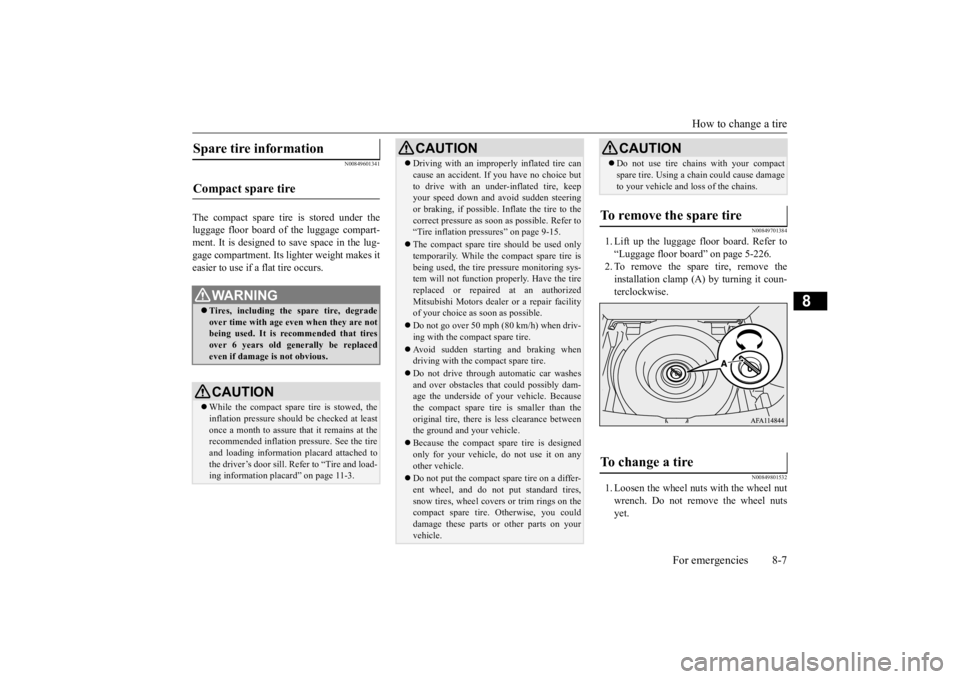
How to change a tire
For emergencies 8-7
8
N00849601341
The compact spare tire is stored under the luggage floor board of the luggage compart-ment. It is designed to save space in the lug- gage compartment. Its lighter weight makes it easier to use if a flat tire occurs.
N00849701384
1. Lift up the luggage floor board. Refer to“Luggage floor board” on page 5-226.2. To remove the spare tire, remove theinstallation clamp (A) by turning it coun- terclockwise.
N00849801532
1. Loosen the wheel nuts with the wheel nut wrench. Do not remove the wheel nuts yet.
Spare tire information Compact spare tire
WA R N I N G Tires, including the spare tire, degrade over time with age even when they are notbeing used. It is recommended that tires over 6 years old generally be replaced even if damage is not obvious.CAUTION While the compact spare tire is stowed, the inflation pressure should be checked at least once a month to assure that it remains at therecommended inflation pressure. See the tire and loading information placard attached to the driver’s door sill. Refer to “Tire and load- ing information placard” on page 11-3.
Driving with an improperly inflated tire can cause an accident. If you have no choice but to drive with an under-inflated tire, keep your speed down and avoid sudden steering or braking, if possible
. Inflate the tire to the
correct pressure as soon as possible. Refer to “Tire inflation pressures” on page 9-15. The compact spare tire should be used only temporarily. While the compact spare tire is being used, the tire pressure monitoring sys-tem will not function properly. Have the tire replaced or repaired at an authorized Mitsubishi Motors dealer or a repair facilityof your choice as soon as possible. Do not go over 50 mph (80 km/h) when driv- ing with the compact spare tire. Avoid sudden starting and braking when driving with the compact spare tire. Do not drive through automatic car washes and over obstacles that could possibly dam- age the underside of your vehicle. Because the compact spare tire is smaller than theoriginal tire, there is less clearance between the ground and your vehicle. Because the compact spare tire is designed only for your vehicle, do not use it on any other vehicle. Do not put the compact spare tire on a differ- ent wheel, and do not put standard tires, snow tires, wheel covers or trim rings on the compact spare tire. Otherwise, you coulddamage these parts or other parts on your vehicle.CAUTION
Do not use tire chains with your compact spare tire. Using a chain could cause damage to your vehicle and loss of the chains.
To remove the spare tire To change a tire
CAUTION
BK0277700US.bo
ok 7 ページ 2019年3月8日 金曜日 午前9時23分
Page 362 of 427
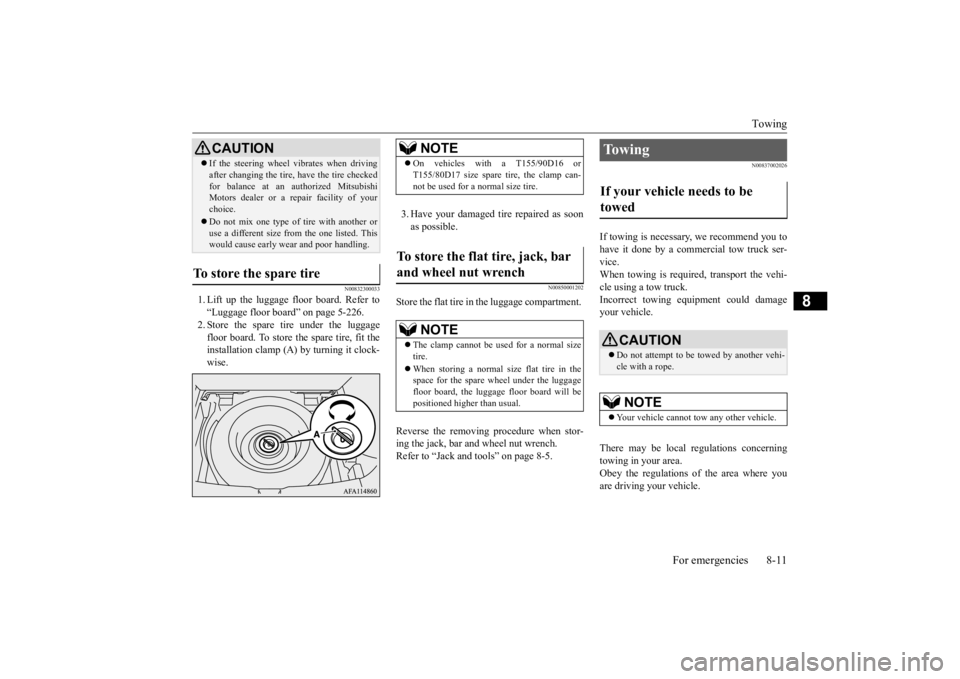
Towing
For emergencies 8-11
8
N00832300033
1. Lift up the luggage floor board. Refer to “Luggage floor board” on page 5-226. 2. Store the spare tire under the luggagefloor board. To store the spare tire, fit the installation clamp (A) by turning it clock- wise.
3. Have your damaged tire repaired as soon as possible.
N00850001202
Store the flat tire in the luggage compartment. Reverse the removing procedure when stor- ing the jack, bar and wheel nut wrench. Refer to “Jack and tools” on page 8-5.
N00837002026
If towing is necessary, we recommend you to have it done by a commercial tow truck ser- vice. When towing is required, transport the vehi-cle using a tow truck.Incorrect towing equipment could damage your vehicle. There may be local regulations concerning towing in your area. Obey the regulations of the area where you are driving your vehicle.
If the steering wheel vibrates when driving after changing the tire, have the tire checked for balance at an authorized Mitsubishi Motors dealer or a repair facility of your choice. Do not mix one type of tire with another or use a different size from the one listed. Thiswould cause early wear and poor handling.
To store the spare tire
CAUTION
NOTE
On vehicles with a T155/90D16 or T155/80D17 size spare tire, the clamp can- not be used for a normal size tire.
To store the flat tire, jack, bar and wheel nut wrench
NOTE
The clamp cannot be us
ed for a normal size
tire. When storing a normal size flat tire in the space for the spare wheel under the luggagefloor board, the luggage floor board will be positioned higher than usual.
To w i n g If your vehicle needs to be towed
CAUTION Do not attempt to be towed by another vehi- cle with a rope.NOTE
Your vehicle cannot tow any other vehicle.
BK0277700US.bo
ok 11 ページ 2019年3月8日 金曜日 午前9時23分
Page 373 of 427
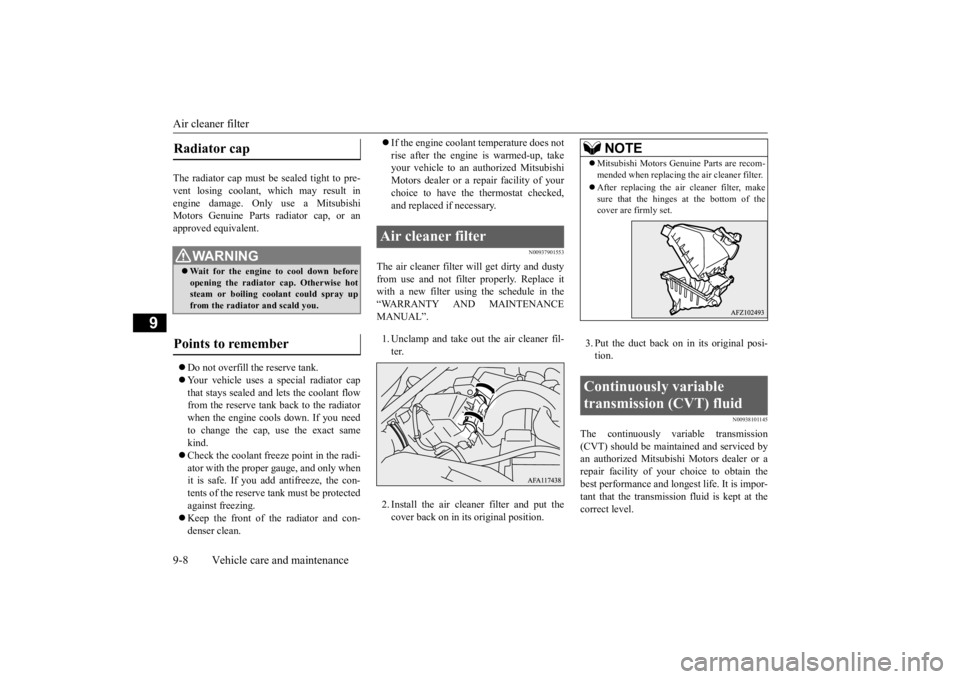
Air cleaner filter 9-8 Vehicle care and maintenance
9
The radiator cap must be
sealed tight to pre-
vent losing coolant, which may result inengine damage. Only use a Mitsubishi Motors Genuine Parts radiator cap, or an approved equivalent. Do not overfill the reserve tank. Your vehicle uses a special radiator cap that stays sealed and lets the coolant flow from the reserve tank back to the radiatorwhen the engine cools down. If you need to change the cap, use the exact same kind. Check the coolant freeze point in the radi- ator with the proper gauge, and only when it is safe. If you add antifreeze, the con-tents of the reserve tank must be protected against freezing. Keep the front of the radiator and con- denser clean.
If the engine coolant temperature does not rise after the engine is warmed-up, take your vehicle to an authorized Mitsubishi Motors dealer or a repair facility of yourchoice to have the thermostat checked, and replaced if necessary.
N00937901553
The air cleaner filter w
ill get dirty and dusty
from use and not filter properly. Replace it with a new filter using the schedule in the “WARRANTY AND MAINTENANCEMANUAL”. 1. Unclamp and take out the air cleaner fil- ter. 2. Install the air cleaner filter and put the cover back on in its original position.
3. Put the duct back on in its original posi- tion.
N00938101145
The continuously variable transmission(CVT) should be maintained and serviced by an authorized Mitsubishi Motors dealer or arepair facility of your choice to obtain the best performance and longest life. It is impor- tant that the transmission fluid is kept at thecorrect level.
Radiator cap
WA R N I N G Wait for the engine to cool down before opening the radiator cap. Otherwise hotsteam or boiling coolant could spray up from the radiator and scald you.
Points to remember
Air cleaner filter
NOTE
Mitsubishi Motors Genuine Parts are recom- mended when replacing the air cleaner filter. After replacing the air cleaner filter, make sure that the hinges at the bottom of thecover are firmly set.
Continuously variable transmission (CVT) fluid
BK0277700US.bo
ok 8 ページ 2019年3月8日 金曜日 午前9時23分
Page 377 of 427
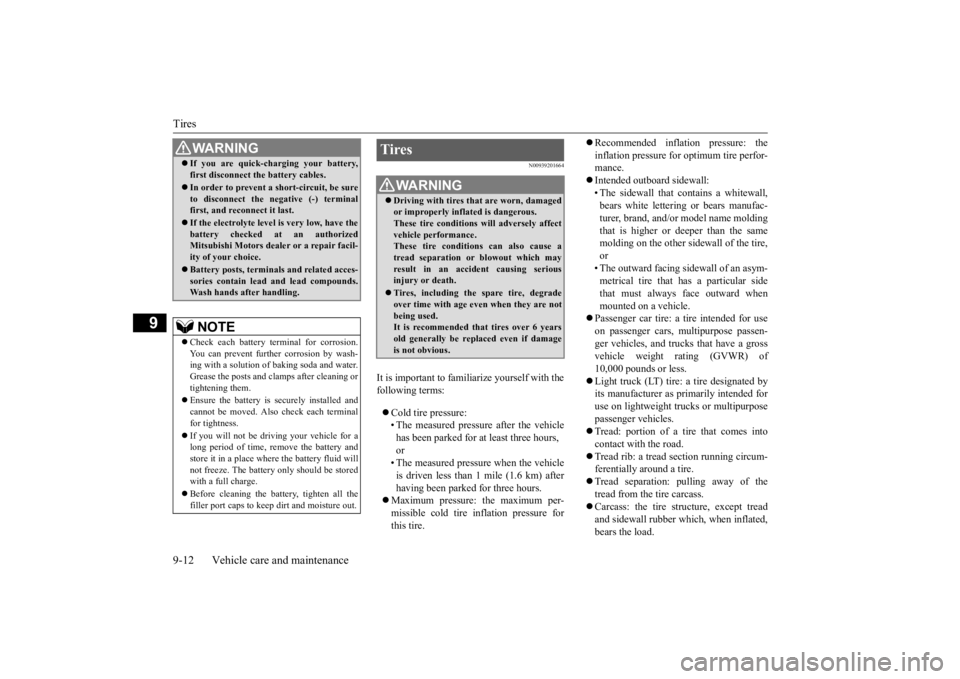
Tires 9-12 Vehicle care and maintenance
9
N00939201664
It is important to familiarize yourself with the following terms: Cold tire pressure: • The measured pressure after the vehicle has been parked for at least three hours,or • The measured pressure when the vehicle is driven less than 1 mile (1.6 km) afterhaving been parked for three hours.
Maximum pressure: the maximum per- missible cold tire inflation pressure forthis tire.
Recommended inflation pressure: the inflation pressure for optimum tire perfor- mance. Intended outboard sidewall: • The sidewall that contains a whitewall, bears white lettering or bears manufac- turer, brand, and/or model name moldingthat is higher or deeper than the same molding on the other sidewall of the tire, or• The outward facing sidewall of an asym-metrical tire that has a particular side that must always face outward when mounted on a vehicle.
Passenger car tire: a tire intended for use on passenger cars,
multipurpose passen-
ger vehicles, and trucks that have a grossvehicle weight rating (GVWR) of 10,000 pounds or less. Light truck (LT) tire: a tire designated by its manufacturer as primarily intended for use on lightweight trucks or multipurpose passenger vehicles. Tread: portion of a tire that comes into contact with the road. Tread rib: a tread section running circum- ferentially around a tire. Tread separation: pulling away of the tread from the tire carcass. Carcass: the tire structure, except tread and sidewall rubber which, when inflated, bears the load.
If you are quick-charging your battery, first disconnect the battery cables. In order to prevent a short-circuit, be sure to disconnect the negative (-) terminalfirst, and reconnect it last. If the electrolyte level is very low, have the battery checked at an authorized Mitsubishi Motors dealer or a repair facil- ity of your choice. Battery posts, terminals and related acces- sories contain lead and lead compounds.Wash hands after handling.NOTE
Check each battery terminal for corrosion. You can prevent further corrosion by wash- ing with a solution of baking soda and water.Grease the posts and clamps after cleaning or tightening them. Ensure the battery is securely installed and cannot be moved. Also check each terminal for tightness. If you will not be driv
ing your vehicle for a
long period of time, remove the battery and store it in a place where the battery fluid will not freeze. The battery only should be storedwith a full charge. Before cleaning the battery, tighten all the filler port caps to keep dirt and moisture out.WA R N I N G
Tires
WA R N I N G Driving with tires that are worn, damaged or improperly inflated is dangerous. These tire conditions will adversely affect vehicle performance.These tire conditions can also cause a tread separation or blowout which may result in an accident causing seriousinjury or death. Tires, including the spare tire, degrade over time with age even when they are not being used. It is recommended that tires over 6 yearsold generally be replaced even if damage is not obvious.
BK0277700US.bo
ok 12 ページ 2019年3月8日 金曜日 午前9時23分
Page 386 of 427
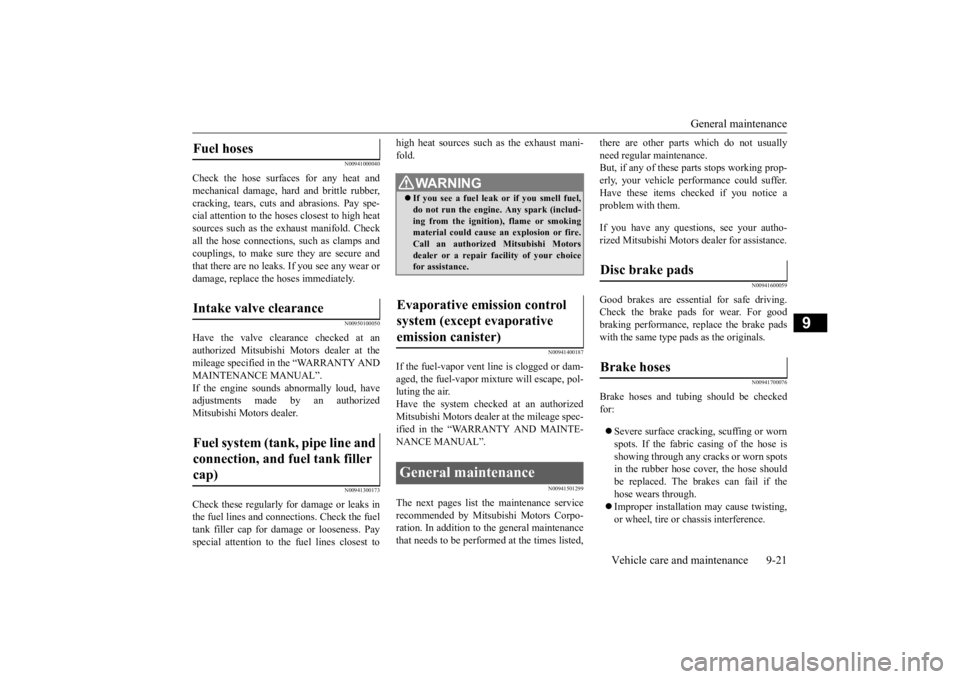
General maintenance
Vehicle care and maintenance 9-21
9
N00941000040
Check the hose surfaces for any heat and mechanical damage, hard and brittle rubber,cracking, tears, cuts and abrasions. Pay spe- cial attention to the hoses closest to high heat sources such as the exhaust manifold. Checkall the hose connections, such as clamps and couplings, to make sure they are secure and that there are no leaks. If you see any wear ordamage, replace the hoses immediately.
N00950100050
Have the valve clearance checked at anauthorized Mitsubishi Motors dealer at themileage specified in the “WARRANTY AND MAINTENANCE MANUAL”. If the engine sounds abnormally loud, haveadjustments made by an authorized Mitsubishi Motors dealer.
N00941300173
Check these regularly for damage or leaks in the fuel lines and connections. Check the fuel tank filler cap for damage or looseness. Pay special attention to the fuel lines closest to
high heat sources such as the exhaust mani- fold.
N00941400187
If the fuel-vapor vent line is clogged or dam- aged, the fuel-vapor mixture will escape, pol- luting the air.Have the system checked at an authorized Mitsubishi Motors dealer at the mileage spec- ified in the “WARRANTY AND MAINTE-NANCE MANUAL”.
N00941501299
The next pages list the maintenance servicerecommended by Mitsubishi Motors Corpo- ration. In addition to the general maintenance that needs to be perfor
med at the times listed,
there are other parts which do not usually need regular maintenance. But, if any of these parts stops working prop- erly, your vehicle performance could suffer.Have these items checked if you notice a problem with them. If you have any questions, see your autho- rized Mitsubishi Motors
dealer for assistance.
N00941600059
Good brakes are essential for safe driving. Check the brake pads for wear. For good braking performance, replace the brake padswith the same type pads as the originals.
N00941700076
Brake hoses and tubing should be checkedfor: Severe surface cracking, scuffing or worn spots. If the fabric casing of the hose is showing through any cracks or worn spotsin the rubber hose cover, the hose should be replaced. The brakes can fail if the hose wears through. Improper installation may cause twisting, or wheel, tire or chassis interference.
Fuel hoses Intake valve clearance Fuel system (tank, pipe line and connection, and fuel tank filler cap)
WA R N I N G If you see a fuel leak or if you smell fuel, do not run the engine. Any spark (includ- ing from the ignition), flame or smokingmaterial could cause an explosion or fire. Call an authorized Mitsubishi Motors dealer or a repair facility of your choicefor assistance.
Evaporative emission control system (except evaporative emission canister) General maintenance
Disc brake pads Brake hoses
BK0277700US.bo
ok 21 ページ 2019年3月8日 金曜日 午前9時23分
Page 391 of 427
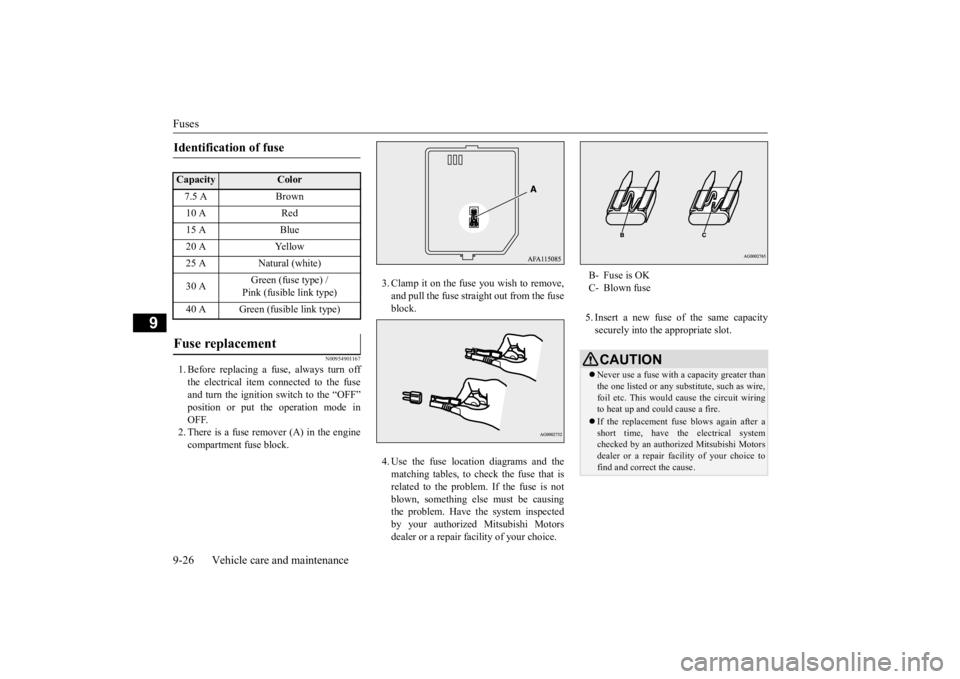
Fuses 9-26 Vehicle care and maintenance
9
N00954901167
1. Before replacing a fuse, always turn off the electrical item connected to the fuse and turn the ignition switch to the “OFF”position or put the operation mode in OFF. 2. There is a fuse remover (A) in the enginecompartment fuse block.
3. Clamp it on the fuse you wish to remove, and pull the fuse straight out from the fuseblock. 4. Use the fuse location diagrams and the matching tables, to check the fuse that is related to the problem. If the fuse is not blown, something else must be causingthe problem. Have the system inspectedby your authorized Mitsubishi Motors dealer or a repair facility of your choice.
5. Insert a new fuse of the same capacity securely into the appropriate slot.
Identification of fuse Capacity
Color
7.5 A Brown10 A Red15 A Blue20 A Yellow25 A Natural (white) 30 A
Green (fuse type) / Pink (fusible link type)
40 A Green (fusible link type)
Fuse replacement
B- Fuse is OK C- Blown fuseCAUTION Never use a fuse with a capacity greater than the one listed or any substitute, such as wire, foil etc. This would cause the circuit wiring to heat up and could cause a fire. If the replacement fuse blows again after a short time, have the electrical systemchecked by an authorized Mitsubishi Motors dealer or a repair faci
lity of your choice to
find and correct the cause.
BK0277700US.bo
ok 26 ページ 2019年3月8日 金曜日 午前9時23分